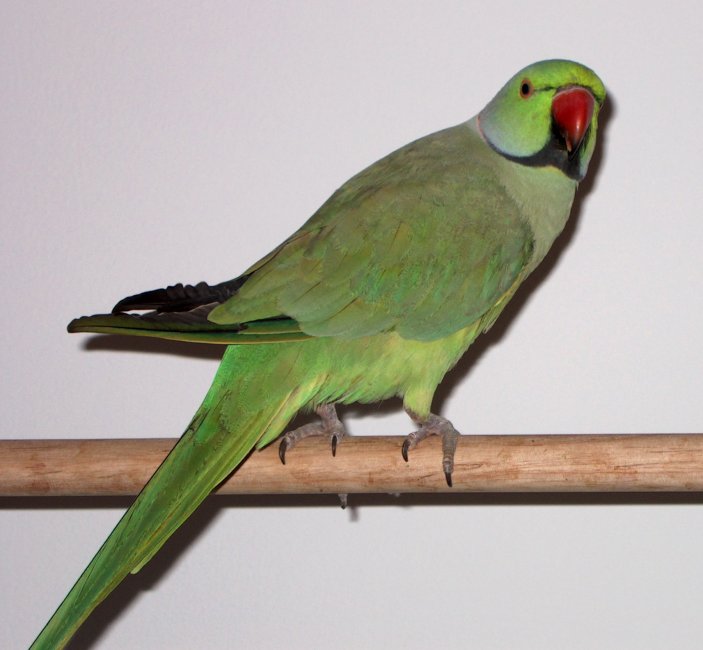
Rose-ringed parakeet, orRing-necked parakeet(Psittacula krameri)
Phylum —chordata
Class — aves
Order — psittaciformes
Family — psittaculidae
Genus – psittacula
Appearance
The rose-ringed parakeet is sexually dimorphic. The adult male sports a red and black neck ring, and the hen and immature birds of both sexes either show no neck rings, or display shadow-like pale to dark grey neck rings. Both sexes have a distinctive green color in the wild, and captive bred ringnecks have multiple color mutations including blue, violet and yellow.
Rose-ringed parakeets measure on average 40 cm (16 in) in length, including the tail feathers, a large portion of their total length. Their average single-wing length is about 15 to 17.5 cm (5.9 to 6.9 in).
Habitat
Ring-necked parakeet is native to central Africa and range from as far north as Egypt, as far west as Senegal, as far east as Ethiopia, and as far south as Uganda. It is also native to parts of Asia such as Afghanistan, Bangladesh, Bhutan, China, India, Nepal, Pakistan, Sri Lanka, and Vietnam.
Behavior
Rose-ringed parakeetis motile, arboreal, and diurnal, but exhibits a daily torpor. This species is also sedentary and social, living in groups.
It has three distinctive calls that are used to communicate with other birds of the same species. However, a young bird has only one call and has to learn the other calls when it matures.
Diet
In the wild, rose-ringed parakeets usually feed on buds, fruits, vegetables, nuts, berries, and seeds. Wild flocks also fly several miles to forage in farmlands and orchards, causing extensive damage.
Reproduction
The rose-ringed parakeet’s nest is a hole in tree. But when they live in towns, they can nest in any available high cavity, such as a crevice in a wall, under a roof, an old magpie nest. The nest is lined with rotten wood.
Female lays 3 to 4 eggs. Incubation lasts about 22 to 24 days, by both parents, but mainly by female. She raises the young too, sometimes helped by the male.
The young fledge about 40-45 days after hatching. They reach the adult plumage at 18 months, and complete adult plumage at 32 months of age.
In captivity
This parakeet species is considered to be a long-lived bird. It can live up to 34 years in captivity.
With adequate attention, handling, and love, arose-ringed parakeetcan quickly become a beloved companion and family member. They enjoy learning new things and are exceptionally proficient with owners who want to challenge their intelligence. That's one reason they develop such large vocabularies and are great at bird tricks.
If you notice any aggressive behavior, it's best to avoid scolding as the bird can develop a lifetime fear of people. The best way to handle this bird is to ignore bad behavior and use positive reinforcement for good behavior.
The cage for this bird needs to be larger than you might expect. It should accommodate its long tail and let the bird hop around and play when you're not around. Make sure the bar spacing isn't large enough for them to get stuck in or escape through; the ideal size is 1/2-inch to 5/8-inch spacing.
Clean the food and water bowl daily, perches and toys weekly, and the floor monthly. Once a year, plan on taking everything outside to be hosed down.
Parakeets are very active birds. As with most other bird species, it is a good idea to have a safe area for the pet to play and stretch its wings out of its cage for at least 3 hours each day. Ring-necked parakeets also have powerful jaw muscles to maintain. It is wise to provide an array of chewable toys, perches, and cage accessories, so the bird is less likely to gnaw on something valuable or dangerous. This species enjoys puzzles and any complex toys you can find, which should help keep the bird busy as well.
Providing a mister and a dish of water to bathe in will also keep your feathered friend very happy.
While most vets agree that it is best for captive birds to eat a nutritionally balanced pelleted diet, a ringneck will appreciate a variety of fruits and vegetables in their diet. Leafy greens and vegetables are crucial for any companion parrot to maintain a nutritionally sound diet, and the rose-ringed parakeet is no exception. They can also eat healthy cooked food you would eat and are particularly fond of chicken, though beans, grains, and rice are also acceptable. Avocados, rhubarb, and chocolate are toxic to birds. Some ringneck owners find that their bird will sort out and leave behind pellets if it's mixed with seeds. These birds seem picky about eating pellets. If you find that to be the case, offer pellets and seeds separately and rotate them on a regular schedule. They usually come around to pellets. As a rule of thumb, start off by offering your bird 1/4 cup of pellets and 1/4 cup of fruits and vegetables daily. Increase the amount as needed. Remove the uneaten foods to prevent spoilage.
As with all birds, food and water containers should be emptied, cleaned, and refilled daily to reduce the risk of bacterial growth and infection.
 Russian
Russian
 English
English























